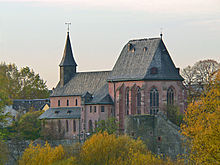History of Höchst am Main
Starting from the mouth of the Niddam, the Lindenweg (also known as the Linienweg), a pre-Roman, straightforward connection over the Taunus crossing at today's Saalburg, led into the Lahn region.
Iron Age graves from the Hallstatt and La Tène periods were also found during construction work, indicating Celtic inhabitants.
The Königsteiner Straße still runs in a north-westerly direction to the Feldberg, and the route along the course of the Main can be found after the Nidda bridge as a connection via Griesheim and the Gutleuthof to Frankfurt.
Subsequently, the village of Höchst developed along the main road between a Mainz Fronhof in the west, which was located in the area of the Wed, and the Justinuskirche in the east.
In the 12th century, the diocese of Mainz appointed a burgrave in Höchst; Count Gotfried von der Wartburg, a relative of Archbishop Henry I, is mentioned in documents.
On February 11, 1355, Emperor Charles IV granted the village of Hoisten (Höchst) city rights against Frankfurt's will in a document issued in Pisa.
The revenue from the customs duties in Höchst, Ehrenfels and Niederlahnstein was a welcome instrument for the financially weak Mainz state to share in the growing wealth of its neighbors.
The settlement of several noble families in Höchst, who alternately occupied the post of Mainz bailiff, led to spatial and economic growth.
[21] In 1463, Diether von Isenburg, who was defeated in the Mainz Collegiate Feud and deposed as Archbishop, was granted the office of Höchst as his own dominion in the Peace of Zeilsheim.
In a further construction phase from 1460 to 1475, the town was once again expanded to the east; the widening of the street in front of the Frankfurter Tor, known as the Storch, served as a new square for the Höchst weekly market.
The Antonite diary records this:[23] 1586 Högst branded in Vigilia Damasi; the Main was frozen for 5 weeks.The Thirty Years' War was also a turning point for Höchst.
On his march from Frankfurt towards Mainz, Bernhard von Weimar had Höchst captured in January 1635 and half of the city and the then Gothic castle burnt down.
Elector Anselm Casimir Wambolt von Umstadt complained about this to the Emperor in a letter dated March of that year:[24] But out of evil intent and poisonous envy, without any benefit or advantage to themselves, they reduced the residential palace built with great cost by our predecessor Wolfgang to ashes, especially down to the walls that were still standing.The town was repeatedly ravaged by enemy troops.
The founding of the famous Höchst porcelain manufactory in 1746 - it produced until 1796 and was re-established in 1947 - and the settlement of the Italian trading family Bolongaro were two important reasons for this upturn.
Elector Emmerich Joseph allowed them to build the Bolongaro Palace as part of his Neustadt project for the urban development of Höchst, which began in 1768.
Although the new settlers were granted many privileges, the construction costs on the difficult terrain were high and there was plenty of cheap building land available in the old town.
The Bolongaros, who had been granted Frankfurt citizenship after all in 1783, left Höchst again and entrusted their authorized signatory Bertina with the management of the tobacco manufactory.
On October 11, 1802, one hundred men of the Nassau military under the leadership of Government Councillor Huth took possession of Höchst in anticipation of the territorial reorganization.
He used the Bolongaro Palace as his headquarters until December 27 of that year.After the end of the Wars of Liberation in 1813, the Nassau government began to improve the infrastructure and reform the administration of the duchy.
In 1822, the entry in a geography book read:[29] Höchst, at the confluence of the Nidda and the Main, with 1516 inhabitants, tobacco and other factories, strong trade.
The last two Höchst customs officials left their posts on February 15, 1867, the office's equipment was auctioned off and the buildings were rented out as private apartments.
With its twelve tracks and the representative Art Nouveau-style station building, it was a symbol of the rapid growth that the town experienced due to its rise as a chemical site.
In 1907, Höchst acquired the Bolongaro Palace, which had previously been used as a residential and industrial building, for the growing city administration and had it converted into a town hall.
He conducted official business by telephone from Frankfurt until 1925, before becoming city treasurer there and handing over his office to Bruno Müller, the last mayor of Höchst.
The Höchst city architect Carl Rohleder had radical plans for a "Groß-Höchst", which envisaged the demolition and redevelopment of almost the entire old town.
In order to avoid having incorporation conditions dictated to it and to continue to benefit from the vital tax revenue, the Höchst magistrate decided to voluntarily relinquish its independence.
The people of Höchst were still waiting for a connection to the Frankfurt tramway, and the contractually promised market hall, indoor swimming pool and Main Bridge had not yet been built.
[40] As the Lord Mayor of Frankfurt, Walter Kolb, lived in a side wing of the Bolongaro Palace, he was able to get a direct impression of the discontent of the people of Höchst.
The number of people employed at Industriepark Höchst fell from over 30,000 (around 1980) to less than 20,000 at times, and the shopping spree that used to be the norm for Rotfabriker employees during their lunch break became a victim of efforts to constantly increase efficiency.
[45] The conversion of a section of Königsteiner Strasse between Bolongarostrasse and Hostatostrasse into a pedestrian zone in 1990 was unable to halt the downward trend in Höchst's retail trade.































